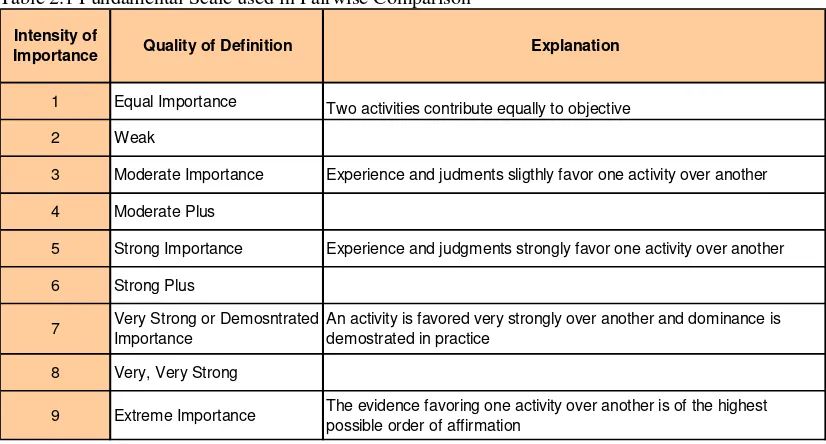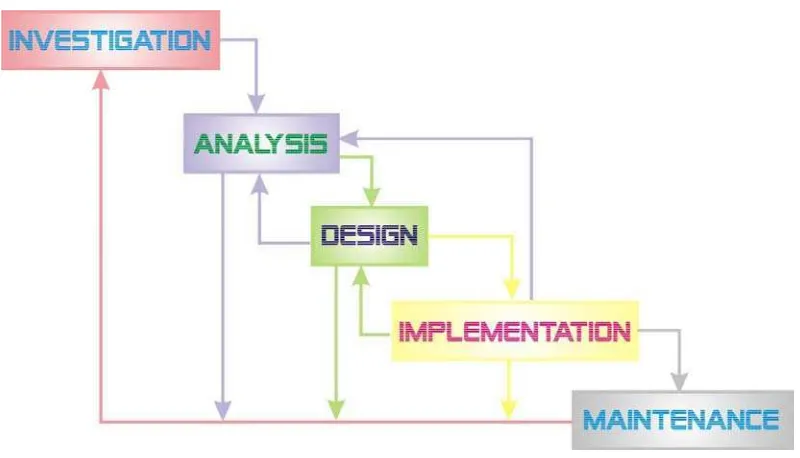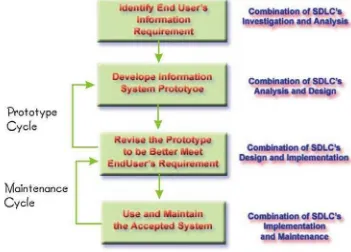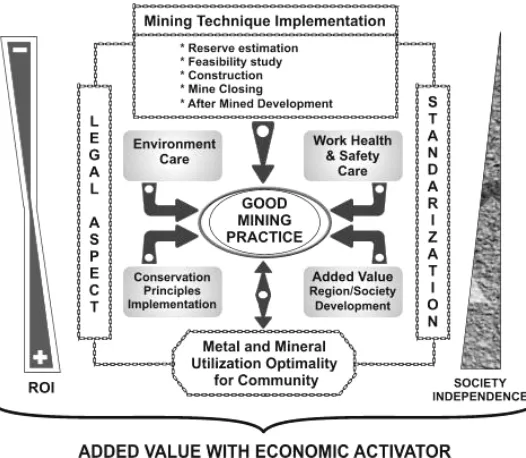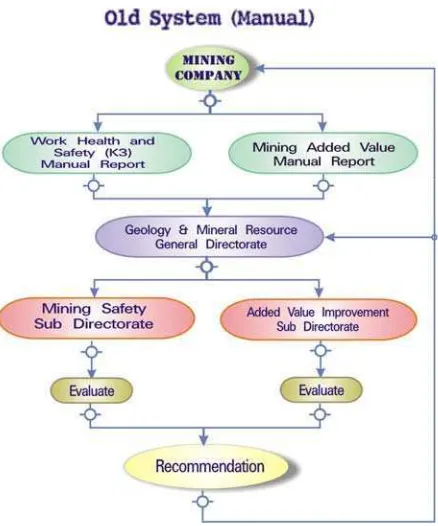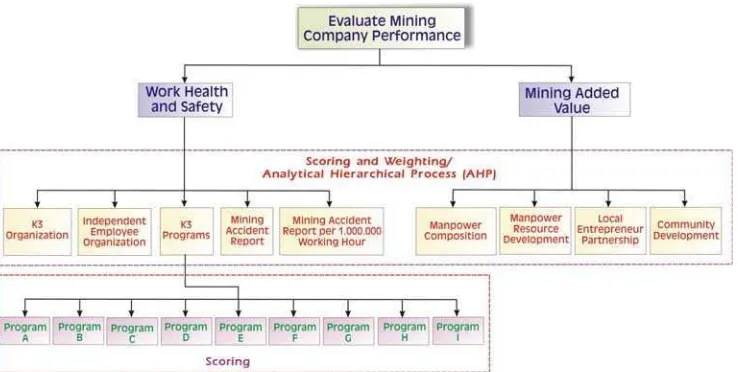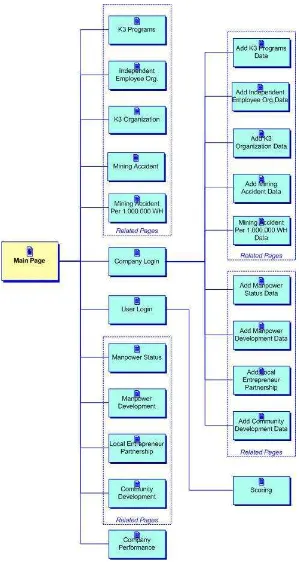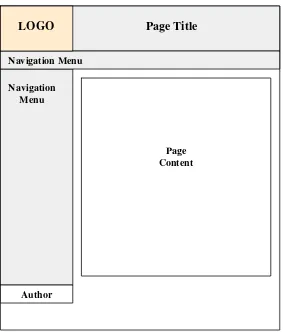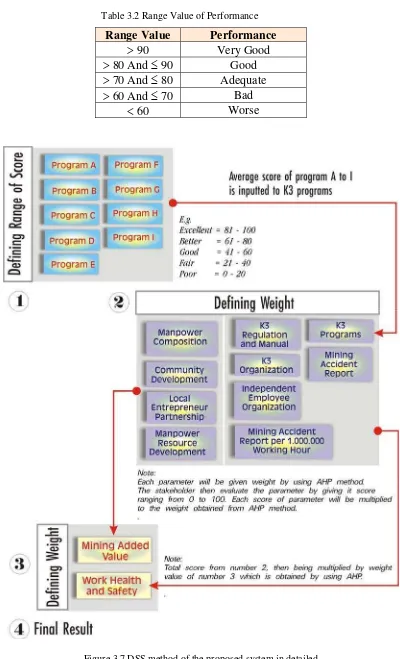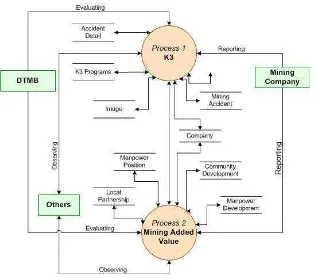D
EVELOPINGD
ECISIONS
UPPORTS
YSTEM(DSS)
A
S AT
OOL INE
VALUATINGM
ININGC
OMPANYP
ERFORMANCEB
ASED ONQ
UALITATIVEP
ARAMETERSANDES JAYARSA
GRADUATE SCHOOL
ABSTRACT
ANDES JAYARSA (2005). Developing Decision Support System (DSS) As a Tool in Evaluating Mining Company Performance Based on Qualitative
Parameters. Under the supervision of KUDANG BORO SEMINAR and IDUNG
RISDIYANTO.
Over the past decades, the mining industry has made a significant contribution to the development of Indonesian economy. It has been a pioneer industry for regional development, and a source of foreign exchange, direct income, jobs and business opportunities for Indonesian citizen. The development of mining industry is in line with the spirit of article 33 of the 1945 Constitution (as amended) that stipulated: “land, water and air are controlled by the state and shall be utilized for the maximum benefits of the people”. In addition, one of the key outcomes of Johannesburg commitments is to support the participation of external stakeholders, and to address the environmental, economic, health, social impacts and benefits of mining, minerals and metals throughout their life-cycles and to foster sustainable mining practices.
Recent days, the term of Good Mining Practice is repeatedly buzzed by the government particularly the Department of Energy and Mineral Resources. The utilization of mineral and energy resources will bring an optimal outcome and minimum side effect if the exploitation management or the process of mineral resources is carried out appropriately according the principle of Good Mining Practice (Propenas 2002-2004). An award to certain mining company who has already carried out good mining practice appropriately is reasonable. Objective evaluation to mining company performance can be done comprehensively regarding the way and the obedient of good mining practice aspects, transparently by involving stakeholders. Thus, an evaluation system needs to be developed to evaluate mining company performance.
The expected output of this research is a Decision Support System (DSS) tool that can be used by government, particularly Department of Mineral and Energy Resources (Technique Directorate of Coal and Mineral) to evaluate mining companies performance regarding Good Mining Practice aspects.
D
EVELOPINGD
ECISIONS
UPPORTS
YSTEM(DSS)
A
S AT
OOL INE
VALUATINGM
ININGC
OMPANYP
ERFORMANCEB
ASED ONQ
UALITATIVEP
ARAMETERSANDES JAYARSA
A Thesis submitted for the degree of Master of Science Of Bogor Agricultural University
MASTER OF SCIENCE IN INFORMATION TECHNOLOGY
FOR NATURAL RESOURCE MANAGEMENT
GRADUATE SCHOOL
Research Title : Developing Decision Support System (DSS) As a Tool in Evaluating Mining Company Performance Based on Qualitative Parameters
Name : Andes Jayarsa
Student ID : G.051030081
Study Program : Master of Science in Information Technology for Natural Resource Management
Approved by, Advisory Board
Dr. Ir. Kudang Boro Seminar, M.Sc Ir. Idung Risdiyanto, M.Sc
Supervisor Co-Supervisor
Endorsed by,
Program Coordinator Dean of The Graduate School
Dr. Ir. Tania June, M.Sc Prof. Dr. Ir. Syafrida Manuwoto, M.Sc
ACKNOWLEDGMENT
Initially, I would like to express my gratefulness to Allah SWT for the favors and mercies to me during the time. I wish to thank to my supervisor Dr. Ir. Kudang Boro Seminar, M.Sc and my co-supervisor Ir. Idung Risdiyanto, M.Sc for the guidance, advices, comments, encouragement and also constructive criticism during the supervision of my research through all months until the research was finished.
I wish also to thank and give most appreciation to MIT student’s batch 2003 for the togetherness, assistances, and the enlightenment we shared for all this time, how we support each other during the study until the last semester of our study. It is really a big gift and honor to me for knowing great people with different background and expertise like you guys. I would like to thank also to the staff of the Master of Science in Information Technology for Natural Resources Management (MIT) Program for the good cooperation and facilitation, special thank also to MIT lectures for sharing and imparting their knowledge and experiences during the time.
CURRICULUM VITAE
Andes Jayarsa was born in Pekanbaru, Riau Province, Indonesia on August 21, 1978. He spent most of his childhood and school from elementary to SMU at Tanjungpinang, Kepulauan Riau Province He achieved his undergraduate degree from National Institute of Technology (ITENAS), Bandung in 2001 in the field of Mechanical Engineering and awarded as the best-graduated student of mechanical engineering department in 2001. In 2002, he worked at foreign manufacturing company as Assistant Process Engineer in Batam.
STATEMENT
I, Andes Jayarsa, here by stated that this thesis entitled:
Developing Decision Support System (DSS) As a Tool in Evaluating Mining
Company Performance Based on Qualitative Parameters
Are results of my own work during the period of March to October 2005 and that it has not been published before. The content of the thesis has been examined by the advising committee and the external examiner.
Bogor, October 2005
L
IST OF
C
ONTENT
List of Content ...i
List of Figures... iii
List of Tables ...v
CHAPTER IINTRODUCTION 1.1 Background...1
1.2 Problem Identification ...5
1.3 Objective...6
1.4 Problem Constraint ... 7
1.5 User Identification ... 7
1.6 Thesis Structure ...8
CHAPTER IILITERATURE REVIEW 2.1 Decision Suport System ...10
2.1.1 Multi-Criteria Decision Making ...11
2.1.2 Analytic Hierarchy Process (AHP)...13
2.2 Database Management System...17
2.2.1 Storage ...18
2.2.2 Retrieval ... 18
2.2.3 Control ... 19
2.3 Information System Development ...20
2.3.1 Information System Definition... 20
2.3.2 The Stage of Information System Development ... 21
2.4 The Internet ...24
2.5 Good Mining Practice ...27
2.5.1 Mining Occupational Safety and Health ... 28
2.5.2 Mining Added Value Improvement... 30
CHAPTER IIIRESEARCH METHODOLOGY 3.1 Time and Location...33
3.2 Research Area...33
3.3 Data Sources ... 34
3.4 Required Tools ... 34
3.5 Methods ... 36
3.5.1 System Development Method ... 36
3.5.2 Mining Accident Statistic ... 43
CHAPTER IVRESULT AND DISCUSSION
4.1 Hardware Selection ...48
4.2 Software Selection...48
4.3 Implementation... 49
4.3.1 Process Modeling ... 49
4.3.2 Conceptual Model ... 52
4.3.3 Logical Model... 53
4.3.4 Physical Design ... 55
4.3.5 Proposed System ... 57
4.3.6 MICES-Qual Database ... 60
4.3.7 Code Constructing ... 62
4.3.8 Testing ... 66
CHAPTER VCONCLUSIONS AND RECOMMENDATION 5.1 Conclusions ...74
5.2 Recommendations ...75
REFERENCE...77
Appendix 1...79
L
IST OF
F
IGURES
Figure 2.1 An example of the AHP hierarchy with three levels ... 16
Figure 2.2 The Role of DBMS (Turban E, 1995) ... 20
Figure 2.3 Information System Components ... 21
Figure 2.4 The framework of Information System Development... 22
Figure 2.5 Prototyping Development Stages (O’Brien, 1999)... 24
Figure 2.6 Basic concepts of Browser and Server Web... 25
Figure 2.7 Good Mining Practice Paradigm (Suyartono, 2003) ... 28
Figure 3.1 Mining Company Map ... 33
Figure 3.2 Research Scheme... 36
Figure 3.3 Current System of Evaluating Mining Company Performance... 37
Figure 3.4 Criteria of each component of Good Mining Practice... 38
Figure 3.5 The Information Hierarchy of MICES-Qual ... 42
Figure 3.6 Web Page Template for MICES-Qual Interface... 43
Figure 3.7 DSS method of the proposed system in detailed ... 47
Figure 4.1 Context Diagram of The System ... 51
Figure 4.2 DFD Level 1 of The System... 51
Figure 4.3 DFD Level 2 Process 1... 52
Figure 4.4 DFD Level 2 Process 2... 52
Figure 4.5 Entity Relationship Diagram ... 54
Figure 4.6 Proposed System For Evaluating Mining Company Performance... 58
Figure 4.7 System Architecture ... 59
Figure 4.8 Event Identification ... 60
Figure 4.9 PHP MyAdmin Environment to create tables ... 61
Figure 4.10 Created Table and SQL ... 61
Figure 4.11 Page uses PHP Script... 63
D
EVELOPINGD
ECISIONS
UPPORTS
YSTEM(DSS)
A
S AT
OOL INE
VALUATINGM
ININGC
OMPANYP
ERFORMANCEB
ASED ONQ
UALITATIVEP
ARAMETERSANDES JAYARSA
GRADUATE SCHOOL
ABSTRACT
ANDES JAYARSA (2005). Developing Decision Support System (DSS) As a Tool in Evaluating Mining Company Performance Based on Qualitative
Parameters. Under the supervision of KUDANG BORO SEMINAR and IDUNG
RISDIYANTO.
Over the past decades, the mining industry has made a significant contribution to the development of Indonesian economy. It has been a pioneer industry for regional development, and a source of foreign exchange, direct income, jobs and business opportunities for Indonesian citizen. The development of mining industry is in line with the spirit of article 33 of the 1945 Constitution (as amended) that stipulated: “land, water and air are controlled by the state and shall be utilized for the maximum benefits of the people”. In addition, one of the key outcomes of Johannesburg commitments is to support the participation of external stakeholders, and to address the environmental, economic, health, social impacts and benefits of mining, minerals and metals throughout their life-cycles and to foster sustainable mining practices.
Recent days, the term of Good Mining Practice is repeatedly buzzed by the government particularly the Department of Energy and Mineral Resources. The utilization of mineral and energy resources will bring an optimal outcome and minimum side effect if the exploitation management or the process of mineral resources is carried out appropriately according the principle of Good Mining Practice (Propenas 2002-2004). An award to certain mining company who has already carried out good mining practice appropriately is reasonable. Objective evaluation to mining company performance can be done comprehensively regarding the way and the obedient of good mining practice aspects, transparently by involving stakeholders. Thus, an evaluation system needs to be developed to evaluate mining company performance.
The expected output of this research is a Decision Support System (DSS) tool that can be used by government, particularly Department of Mineral and Energy Resources (Technique Directorate of Coal and Mineral) to evaluate mining companies performance regarding Good Mining Practice aspects.
D
EVELOPINGD
ECISIONS
UPPORTS
YSTEM(DSS)
A
S AT
OOL INE
VALUATINGM
ININGC
OMPANYP
ERFORMANCEB
ASED ONQ
UALITATIVEP
ARAMETERSANDES JAYARSA
A Thesis submitted for the degree of Master of Science Of Bogor Agricultural University
MASTER OF SCIENCE IN INFORMATION TECHNOLOGY
FOR NATURAL RESOURCE MANAGEMENT
GRADUATE SCHOOL
Research Title : Developing Decision Support System (DSS) As a Tool in Evaluating Mining Company Performance Based on Qualitative Parameters
Name : Andes Jayarsa
Student ID : G.051030081
Study Program : Master of Science in Information Technology for Natural Resource Management
Approved by, Advisory Board
Dr. Ir. Kudang Boro Seminar, M.Sc Ir. Idung Risdiyanto, M.Sc
Supervisor Co-Supervisor
Endorsed by,
Program Coordinator Dean of The Graduate School
Dr. Ir. Tania June, M.Sc Prof. Dr. Ir. Syafrida Manuwoto, M.Sc
ACKNOWLEDGMENT
Initially, I would like to express my gratefulness to Allah SWT for the favors and mercies to me during the time. I wish to thank to my supervisor Dr. Ir. Kudang Boro Seminar, M.Sc and my co-supervisor Ir. Idung Risdiyanto, M.Sc for the guidance, advices, comments, encouragement and also constructive criticism during the supervision of my research through all months until the research was finished.
I wish also to thank and give most appreciation to MIT student’s batch 2003 for the togetherness, assistances, and the enlightenment we shared for all this time, how we support each other during the study until the last semester of our study. It is really a big gift and honor to me for knowing great people with different background and expertise like you guys. I would like to thank also to the staff of the Master of Science in Information Technology for Natural Resources Management (MIT) Program for the good cooperation and facilitation, special thank also to MIT lectures for sharing and imparting their knowledge and experiences during the time.
CURRICULUM VITAE
Andes Jayarsa was born in Pekanbaru, Riau Province, Indonesia on August 21, 1978. He spent most of his childhood and school from elementary to SMU at Tanjungpinang, Kepulauan Riau Province He achieved his undergraduate degree from National Institute of Technology (ITENAS), Bandung in 2001 in the field of Mechanical Engineering and awarded as the best-graduated student of mechanical engineering department in 2001. In 2002, he worked at foreign manufacturing company as Assistant Process Engineer in Batam.
STATEMENT
I, Andes Jayarsa, here by stated that this thesis entitled:
Developing Decision Support System (DSS) As a Tool in Evaluating Mining
Company Performance Based on Qualitative Parameters
Are results of my own work during the period of March to October 2005 and that it has not been published before. The content of the thesis has been examined by the advising committee and the external examiner.
Bogor, October 2005
L
IST OF
C
ONTENT
List of Content ...i
List of Figures... iii
List of Tables ...v
CHAPTER IINTRODUCTION 1.1 Background...1
1.2 Problem Identification ...5
1.3 Objective...6
1.4 Problem Constraint ... 7
1.5 User Identification ... 7
1.6 Thesis Structure ...8
CHAPTER IILITERATURE REVIEW 2.1 Decision Suport System ...10
2.1.1 Multi-Criteria Decision Making ...11
2.1.2 Analytic Hierarchy Process (AHP)...13
2.2 Database Management System...17
2.2.1 Storage ...18
2.2.2 Retrieval ... 18
2.2.3 Control ... 19
2.3 Information System Development ...20
2.3.1 Information System Definition... 20
2.3.2 The Stage of Information System Development ... 21
2.4 The Internet ...24
2.5 Good Mining Practice ...27
2.5.1 Mining Occupational Safety and Health ... 28
2.5.2 Mining Added Value Improvement... 30
CHAPTER IIIRESEARCH METHODOLOGY 3.1 Time and Location...33
3.2 Research Area...33
3.3 Data Sources ... 34
3.4 Required Tools ... 34
3.5 Methods ... 36
3.5.1 System Development Method ... 36
3.5.2 Mining Accident Statistic ... 43
CHAPTER IVRESULT AND DISCUSSION
4.1 Hardware Selection ...48
4.2 Software Selection...48
4.3 Implementation... 49
4.3.1 Process Modeling ... 49
4.3.2 Conceptual Model ... 52
4.3.3 Logical Model... 53
4.3.4 Physical Design ... 55
4.3.5 Proposed System ... 57
4.3.6 MICES-Qual Database ... 60
4.3.7 Code Constructing ... 62
4.3.8 Testing ... 66
CHAPTER VCONCLUSIONS AND RECOMMENDATION 5.1 Conclusions ...74
5.2 Recommendations ...75
REFERENCE...77
Appendix 1...79
L
IST OF
F
IGURES
Figure 2.1 An example of the AHP hierarchy with three levels ... 16
Figure 2.2 The Role of DBMS (Turban E, 1995) ... 20
Figure 2.3 Information System Components ... 21
Figure 2.4 The framework of Information System Development... 22
Figure 2.5 Prototyping Development Stages (O’Brien, 1999)... 24
Figure 2.6 Basic concepts of Browser and Server Web... 25
Figure 2.7 Good Mining Practice Paradigm (Suyartono, 2003) ... 28
Figure 3.1 Mining Company Map ... 33
Figure 3.2 Research Scheme... 36
Figure 3.3 Current System of Evaluating Mining Company Performance... 37
Figure 3.4 Criteria of each component of Good Mining Practice... 38
Figure 3.5 The Information Hierarchy of MICES-Qual ... 42
Figure 3.6 Web Page Template for MICES-Qual Interface... 43
Figure 3.7 DSS method of the proposed system in detailed ... 47
Figure 4.1 Context Diagram of The System ... 51
Figure 4.2 DFD Level 1 of The System... 51
Figure 4.3 DFD Level 2 Process 1... 52
Figure 4.4 DFD Level 2 Process 2... 52
Figure 4.5 Entity Relationship Diagram ... 54
Figure 4.6 Proposed System For Evaluating Mining Company Performance... 58
Figure 4.7 System Architecture ... 59
Figure 4.8 Event Identification ... 60
Figure 4.9 PHP MyAdmin Environment to create tables ... 61
Figure 4.10 Created Table and SQL ... 61
Figure 4.11 Page uses PHP Script... 63
Figure 4.13 Acquiring information from the map... 62
Figure 4.14 Main For of DSS Tool ... 65
Figure 4.15 Form To Derive Weight (AHP Method) ... 66
Figure 4.16 Login Page for Mining Company... 67
Figure 4.17 Form to Input a New Data ... 67
Figure 4.18 Table Where the Data Saved ... 68
Figure 4.19 User’s Login Page ... 68
Figure 4.20 K3 Programs Summary ... 69
Figure 4.21 Page Used for Scoring ... 69
Figure 4.22 AHP Form ... 70
Figure 4.23 Result of AHP Process ... 71
Figure 4.24 Mining Company Performance Evaluation Result... 71
L
IST OF
T
ABLES
Research Thesis– Bogor Agricultural University
MICES-Q
UAL
M
ANUAL
Welcome to the MICES-Qual program. This program will provide assistance in evaluating particular mining company performance. MICES-Qual consists of two main applications, which are web application and desktop application. Web application is used as a tool in inputting data directly through internet and also used to score particular mining company, while desktop application is used to evaluate score submitted through web application.
WEB APPLICATION
1. Main Page
This main page will appear if the user uses internet connection by typing the website address.
2. Navigation Menu
Research Thesis– Bogor Agricultural University
For example, if user click K3_Programs menu, the next figure will appear on the screen.
User can select particular mining company to see their K3 Program in a certain year. Figure below shows the result of K3 Programs of PT. Newmont Nusa Tenggara in year 2000.
3. Login Menu
Research Thesis– Bogor Agricultural University
Used by stakeholder Used by mining
company
A. Company Login
If this menu were clicked, login page for mining company will appear.
If the user name and password typed by user is correct, the next figure will appear. This page contains of good mining practice components that can be clicked in order to submit the report.
Research Thesis– Bogor Agricultural University
Mining company can fill their data by completing the form provided as seen in the above figure. Then, click “SAVE” button if they want to save the data.
B. User Login
If this menu were clicked, the next page will appear. The user should fill this page correctly by typing a correct username and password.
Research Thesis– Bogor Agricultural University
After all boxes have been filled, then the user can click “SAVE” button in order to save their score for particular mining company.
DESKTOP APPLICATION
1. Main Form
Research Thesis– Bogor Agricultural University
There are three menus available, but the most important menu is Analysis menu where consists of several sub menu, which are View Scoring Summary, Parameter Weighting and Evaluate Company Performance.
2. View Scoring Menu
If this menu were clicked, the next form will appear.
Research Thesis– Bogor Agricultural University
Mining company name and year that
want to be viewed View button to see the summary
Score summary
Mean Score
3. Parameter Weighting Menu
Research Thesis– Bogor Agricultural University
After the boxes have been filled, user can click SYNTHESIZE MATRIX to see whether our judgment regarding the priority of each component is consistent or not.
The form above shows the weighting result. It contains information regarding weight for each component, and CR (Consistency Ratio). CR should be less then 0.1, if CR more than 0.1 then our judgment should be reviewed again. The weight then can be saved by clicking “SAVE” button.
4. Evaluate Company Performance Menu
Research Thesis– Bogor Agricultural University
The figure below shows the sample result of performance evaluation. It contains information about final score for particular mining company, and indicator to show whether that company performance is Very Good, Good, Adequate, Bad or Worse for a certain year.
Research Thesis– Bogor Agricultural University
To see the performance of particular mining company, user should click
button first, then on the map, click the company that want to be seen its performance. After it has been clicked, on the information box, there will be information regarding that company.
Research Thesis – Bogor Agricultural University
C
HAPTER
I
I
NTRODUCTION
1.1 BACKGROUND
Over the past decades, the mining industry has made a significant contribution to the development of Indonesian economy. It has been a pioneer industry for regional development, and a source of foreign exchange, direct income, jobs and business opportunities for Indonesian citizen. The development of mining industry is in line with the spirit of article 33 of the 1945 Constitution (as amended) that stipulated: “land, water and air are controlled by the state and shall be utilized for the maximum benefits of the people”. In addition, one of the key outcomes of Johannesburg commitments is to support the participation of external stakeholders, and to address the environmental, economic, health, social impacts and benefits of mining, minerals and metals throughout their life-cycles and to foster sustainable mining practices.
Recent days, the term of Good Mining Practice is often buzzed by the government particularly the Department of Mineral and Energy Resources. The utilization of mineral and energy resources will bring an optimal outcome and minimum side effect if the exploitation management or the process of mineral resources is carried out appropriately according the principle of Good Mining Practice (Propenas 2002-2004).
Research Thesis – Bogor Agricultural University
environmental functions can be protected and also the safety of people who involves in it is also being guaranteed. The application of good mining practice will obstruct the emerge of environmental and community social shocked cases. Good mining practice which concern to environmental concept is carried out by giving attention to some aspects, which are Mining Occupational Safety and Health (Keselamatan dan Kesehatan Kerja – K3), environmental management and protection, the effort of increasing added value of mineral resources, and mining conservation. All of this aspect must be carried out in the frame of Indonesian laws.
An award to certain mining company who has already carried out good mining practice appropriately is reasonable. Objective evaluation to mining company performance can be done comprehensively regarding the way and the obedient of good mining practice aspects, transparently by involving stakeholders. Thus, an evaluation system needs to be developed to evaluate mining company performance.
In assessing and monitoring mining company performance regarding the obedient to good mining practice aspects, information system is one of the important factors that need to be considered. Haklay (1999) in Mulyarto (2003) stated that it’s virtually important to think about environmental research without relying heavily on digital technology. Information system casts a shadow over almost every aspects of the environment debate: research, monitoring, management, and decision-making.
Research Thesis – Bogor Agricultural University
is no standardization. This situation will bring difficulties to the government in evaluating the report. Moreover, the report is not integrated. Meaning that, each aspect of good mining practice is separated. The other disadvantage of the available system is it cannot be accessed directly by the people. Institution (Educational, Research Institution, Mining Company Association) and public (community, Observer and NGO) do not know what is going on to the company regarding its contribution to local people or their activity influence to the environment. They cannot know the history of company activities. If some shocked cases occurred, they will blame each other without knowing what is the cause of the problem.
Research Thesis – Bogor Agricultural University
without regard for geographic location. The Internet has been described as a technology that has created rapid global integration and is referred to as the “information superhighway”. Mining companies can update their reports directly through Internet, in other hand stakeholder can access the reports almost in the same time.
There are several approaches of developing information system. Two major approaches are structured and object oriented approach. This research will adopt object oriented (OO) approach because of its advantages. Object oriented technology is not a new thing as most people assume, but it is certainly an interesting topic. According to Nugroho (2002) the main factor of discovering object-oriented approach is due to the disadvantages of structured approach: the difficulties of maintenance, longer accomplishment time, high cost of software development and others. Some characteristics of object-oriented approach are big program can be divided into objects, functions that operate data is integrated in the same object, objects can communicate each other by sending messages.
Research Thesis – Bogor Agricultural University
rather than procedures since people think in objects. Since it’s more natural to think of a system in objects, it is understandable why OO technology is gaining popularity.
1.2 PROBLEM IDENTIFCATION
The current system of reporting mining company activities is done manually. The report from mining company is submitted directly to the government, in this case Department of Mineral and Energy Resources through its Directorate of Mineral and Coal Technique. There are some disadvantages found in this system, which are:
1. Format of the report is not standardized. It means that every mining company makes their report based on their style. This will bring difficulties to the government in evaluating the report.
2. The evaluation of mining company is done partially for each good mining practice components.
3. The report never been released to the public. Stakeholders as the party who are always affected by mining company activities never knows what is going on to their environment due to mining activities in their neighborhood or what is the contribution that mining companies have made to support local economic growth, etc.
Research Thesis – Bogor Agricultural University
1.3 OBJECTIVE
The expected output of this research is a Decision Support System (DSS) tool that can be used by government, particularly Department of Mineral and Energy Resources (Directorate of Mineral and Coal Technique) to evaluate mining companies performance regarding Good Mining Practice aspects. In order to achieve that, the objective of this research will be divided into three, which are: 1. To develop database system for inventorying each aspect of good mining
practice parameters (Mining Occupational Safety and Health, the effort of increasing added value of mineral resources) for each mining company. 2. To develop a web that can be used by mining companies to submit their
report directly through Internet. Through this web, the process will be faster and it will raise more transparency to the stakeholder since each stakeholder can see and monitor the report directly.
3. To develop decision support system tool called Mining Company Evaluation System Based on Qualitative Parameters (MICES-Qual), regarding mining companies obedient to the aspects contained in good mining practice manual.
Research Thesis – Bogor Agricultural University
1.4 PROBLEM CONSTRAINT AND ASSUMPTION
There are 4 aspects in good mining practice that should be considered, which are Mining Occupational Safety and Health (K3), Mining Environmental Protection, Mining Added Value Improvement and Mining Conservation. These 4 aspects can be grouped into 2 main aspects, which are qualitative aspect (K3 and Mining Added Value Improvement aspect) and quantitative aspect (Mining Environmental Protection and Mining Conservation). Since each aspect consists of many parameters that should be included in evaluating mining company performance, so this research will be constrained on qualitative aspects only, which are K3 and mining added value aspect.
This research used assumption that there will be no bias value in scoring particular mining company; every evaluator will give the appropriate score to a mining company they scored. There will be no extreme condition where one evaluator gives a score contradictory to other evaluator. For example one evaluator gives 100 to particular component of good mining practice while others give 0 or 20 for the same component evaluated.
1.5 USER IDENTIFICATION
Potential users of this system which are classified as stakeholders can be grouped into 3 types, which are:
1. Actor
Research Thesis – Bogor Agricultural University
2. Observer
Observer consists of institution (academic community, research institution, and mining expertise association) and public (local community, independent observer or NGO who is concerning about mining activities). Selected observer will monitor reports of particular mining company and giving value or rate regarding the report based on their own expertise.
3. Evaluator
The evaluator of this system is the Department of Energy and Mineral Resources (DESDM). The evaluator will summary all of the rated report by the observer, and giving final evaluation regarding the performance of mining companies.
1.6 THESIS STRUCTURE
The thesis is structured into five chapters. Each chapter is described as follows:
Chapter 1 describes research background, problem identification, objective, problem constraints, and user identification.
Research Thesis – Bogor Agricultural University
Chapter 3 describes research methodology in building this system. It includes data sources, tools used in the research, location, database design, information system development and decision support system development.
Chapter 4, which is Result and Discussion, describes analysis result after the system is implemented.
Research Thesis – Bogor Agricultural University
C
HAPTER
II
L
ITERATURE
R
EVIEW
A software or information system is not being made effortlessly. The making and development of software or information system often needs big amount of money and time. For that reason, the development of information system or software constitute strategic decision that must be done by top level managers in one company, based on information given by system analyst.
2.1 DECISION SUPPORT SYSTEM
What is Decision Support System (DSS)? The concept of DSS was first articulated in 1970s by Scott Morton under term management decision systems. He defined such systems as “interactive computer-based systems, which help decision makers utilize data and models to solve unstructured problems”. Another definition of DSS introduced by Keen and Scott Morton (1978) follows:
“Decision support system couple the intellectual resources of
individuals with the capabilities of the computer to improve the quality
of decisions. It is a computer-based support system for management
decision makers who deal with semi-structured problems.”
computer-Research Thesis – Bogor Agricultural University
based information system, specially developed for supporting the solution of a non-structured management problem for improving decision making. It utilizes data, it provides easy user interface, and it allows for the decision maker’s own insight.
Aiding the deficiencies of human judgment and decision making has been a major focus of science through its history, because in many situations the quality of decisions is important, as particularly in complex systems, as management of organizational operations, industrial processes, or bidding processes (Seydel and Olson, 2001).
2.1.1Multi-Criteria Decision Making
Project managers are faced with a complex decision environments and problems in their projects. The elements of the problems are numerous, and the inter-relationships among the elements are extremely complicated. Relationships between elements of a problem may be highly nonlinear; changes in the elements may not be related by simple proportionality. Furthermore, human value and judgment systems are integral elements of project problems (Al-Harbi, 1999). Therefore, the ability to make sound decisions is very important to the success of a project.
Research Thesis – Bogor Agricultural University
objectives, and through exploring these in the context of the problem to guide them in identifying a preferred course of action (Al-Harbi, 1999). In other words, MCDM is useful in circumstances which necessitate the consideration of different courses of action, which can not be evaluated by the measurement of a simple, single dimension.
Good Mining Practice involves integration of many criteria. These criteria used by government for evaluating mining company performance. Criteria here are competing with one another; criteria are both qualitative and quantitative. So the evaluation of mining company performance is a multiple criteria decision-making process.
Commonly used MCDM methods in decision-making are ranking and rating. These methods lack theoretical foundation in deciding the weights. These methods assign the weights rather arbitrarily. They don’t take comparison among the criteria and classes into considerations. Moreover, the outcomes of such analysis are aggregated using simple Boolean overlay or weighted aggregation. Both the methods are supposed to yield similar results, which they never do (Prakash, 2003). The reason is being with the logic of aggregation. The Boolean method of characterizing the criteria is too black and white. Boolean intersection (AND) results in a very strict output, i.e. if it fails to fulfill single criteria a region will be excluded from the results (Black). In contrast, Boolean union (OR) will include an area in the result if that area fulfils a single criteria (White).
Research Thesis – Bogor Agricultural University
hierarchical organization of the criteria, which is the basic principle of Analytical Hierarchy Process (AHP). Hence it shows that they have just used the matrix pair wise comparison as a tool to derive weights. They have not implemented the AHP as a whole for decision-making. AHP is a widely used method in decision-making and is introduced by Saaty (1977). It is developed to select the best from a number of alternatives with respect to several criteria. AHP allows for both the inconsistency in the decision and provide the means to improve the consistency. Here the decision maker or the user will perform simple Pairwise Comparison i.e. he/she will compare two elements at a time.
The values of the Pairwise Comparison are determined according to the scale introduced by Saaty. The available values for the comparison are the member of the set: {9,8, 7, 6, 5, 4, 3, 2, 1, 1/2, 1/3, 1/4, 1/5, 1/6, 1/7, 1/8, 1/9}, 9 representing absolute importance and 1/9 the absolute triviality. The AHP gained high popularity because of easiness in obtaining the weights and capacity to integrate heterogeneous data, and therefore AHP is applied in a wide variety of decision problems.
2.1.2Analytic Hierarchy Process (AHP)
Research Thesis – Bogor Agricultural University
adopt Ceballos-Silva and Lopez-Blanco (2003) method, where the weighting process will use pairwise comparison matrix for each criterion.
Analytic means the separation of an entity into its constituents. This method decomposes the complex decision problems into simple groups and hierarchies. Hierarchical organization of the criteria is common in large decision problems. This is advantageous in the decision making process, where relative importance of the criteria under evaluation is to be established consciously. It is proven that the human brain is not able to process more than seven stimuli at a time (Miller, 1956 in Prakash, 2003). Besides, empirical studies showed that people couldn’t compare more than three criteria at the same time (Rommelfanger, 2003). Therefore, a hierarchical organization of the criteria helps to decompose the complex decision making processes, as suitability evaluation. A particular hierarchy or group helps to maintain the consistency among the comparisons and weightings of the criteria. Moreover, criteria that are comparable to each other are organized at the same level. Furthermore, the hierarchical structure has the ability to incorporate decisions or expert knowledge of people from various domains, especially while an environmental decision problem is an interdisciplinary terrain The decision-making in AHP is a continuous process starting from analyzing the decision environment to understand and arrange the criteria into different groups and levels till evaluating the criteria in its decision outputs.
Research Thesis – Bogor Agricultural University
[image:47.595.114.527.258.480.2]are measured on a ratio scale. First, a decision-maker has to make comparison between each element under evaluation. Here, the comparisons are made qualitatively, for example weak preference, moderate preference etc., and are termed as Pairwise Comparisons (PCs). Later, these preferences are converted to quantitative values using the scale designed by Saaty (1977). (Table 2.1).
Table 2.1 Fundamental Scale used in Pairwise Comparison
1 Equal Importance Two activities contribute equally to objective
2 Weak
3 Moderate Importance Experience and judments sligthly favor one activity over another
4 Moderate Plus
5 Strong Importance Experience and judgments strongly favor one activity over another
6 Strong Plus
7 Very Strong or Demosntrated
Importance
An activity is favored very strongly over another and dominance is demostrated in practice
8 Very, Very Strong
9 Extreme Importance The evidence favoring one activity over another is of the highest
possible order of affirmation
Intensity of
Importance Quality of Definition Explanation
Saaty developed the following steps for applying the AHP (Al-Harbi, 1999): 1. Define the problem and determine its goal.
Research Thesis – Bogor Agricultural University
Figure 2.1 An example of the AHP hierarchy with three levels
3. Construct a set of pair-wise comparison matrices (size n x n) for each of the lower levels with one matrix for each element in the level immediately above by using the relative scale measurement shown in Table 2.1. The pair-wise comparisons are done in terms of which element dominates the other. The pairwise comparison matrix (PCM) is a reciprocal matrix in which elements under its main diagonal are inverses of the upper elements. For instance, the matrix C below presents a PCM obtained from pairwise comparison of the three criteria (C1, C2, and C3) with respect to the goal.
1 2 1 5 1 c 2 1 3 1 c 5 3 1 c c c c C 3 2 1 3 2 1 =
4. There are n(n – 1)/2 judgments required to develop the set of matrices in
Research Thesis – Bogor Agricultural University
5. Hierarchical synthesis is now used to weight the eigenvectors by the weights of the criteria and the sum is taken over all weighted eigenvector entries corresponding to those in the next lower level of the hierarchy. 6. Having made all the pair-wise comparisons, the consistency is determined
by using the eigenvalue, λmax, to calculate the consistency index, CI as
follows: CI = (λmax – n)/(n – 1), where n is the matrix size. Judgment
consistency can be checked by taking the consistency ratio (CR) of CI with the appropriate value in Table 2.2. The CR is acceptable, if it does not exceed 0.10. If it is more, the judgment matrix is inconsistent. To obtain a consistent matrix, judgments should be reviewed and improved. 7. Steps 3 - 6 are performed for all levels in the hierarchy.
Table 2.2. Average random consistency (RI)
Size of Matrix 1 2 3 4 5 6 7 8 9 10
Random Consistency 0 0 0.58 0.9 1.12 1.24 1.32 1.41 1.45 1.49
2.2 DATABASE MANAGEMENT SYSTEM
Research Thesis – Bogor Agricultural University
Collection of data group (archives) that related each other, which is
organized in such way so that in the future it can be utilized again quickly and easily.
Collection of interrelated data kept together in such a way without
unnecessary redundancy, to fulfill many kinds of needs.
Collection of files/tables/archives that related each other, kept in electronic
storage medium.
DBMS performs three basic functions. It enables storage of data in the database, retrieval of data from the database, and control of the database.
2.2.1Storage
DBMS varies the configuration of the stored data. Mainframe systems store many large files, each containing many records, each record containing many data items, and the data items containing many characters. The systems for microcomputer offer more constrained capacities because of limited primary and secondary storage spaces. (This limitation is becoming less and less factor.)
2.2.2Retrieval
Research Thesis – Bogor Agricultural University
2.2.3Control
Much of the control activity of the DBMS is invisible to users. The users ask for some information and receive it without knowing the process that the DBMS has performed. The DBMS can be designed to screen each request for information and determine that (1) the person making the request is indeed an authorized user, (2) the person has access to requested file, and (3) the person has access to the requested data items in the file. A mainframe DBMS might perform all the control functions very well.
There are some capabilities of DBMS in DSS (Turban, 1995), which are:
Captures/extract data for inclusion in a DSS database
Quickly updates (adds, deletes, changes) data records and files
Interrelates data from different sources
Quickly retrieves data from a database for queries and reports
Provides comprehensive data security (protection from unauthorized access,
recovery capabilities, etc.)
Handles personal and unofficial data so that users can experiment with
alternative solutions based on their own judgment
Performs complex retrieval and data manipulation tasks based on queries
Research Thesis – Bogor Agricultural University
Figure 2.2. The Role of DBMS (Turban, 1995)
2.3 INFORMATION SYSTEM DEVELOPMENT
2.3.1Information System Definition
An Information System (IS) is a set of people and procedures, and resources (dataware, hardware, and software) that collects, transforms, maintains, and disseminates information in an organization (O’Brien, 1999). According to Altar (1992) in Kadir (2003), Information system is a combination between working procedures, information, peoples, and information technology which is organized to achieve the goal in one organization.
Research Thesis – Bogor Agricultural University
In the real situation, not all information system can cover all those components. For example, Personal information systems that only involve one user and computer, without occupying network facility and communication. However, workgroup information systems involve several people and number of computer and occupying network facility and communication.
2.3.2The Stage of Information System Development
The development of information system can have two meaning; the first one is to develop new information system from the scratch, the second one is to complete the existing system to be perfect. But sometimes the development of computer based information system is carried out with motivation to utilize the computer as helping tool which is known as quick, accurate, tired and non-bored tool to perform user instructions.
Generally, an information system needs to be replaced or developed because some reasons (Jogiyanto, 1995 in Nugroho, 2002):
1. There is problem found in the old system.
The problem in old system could be inaccuracy in writing the data, information that often late or difficulty in acquiring when it is needed, operational inefficiency, and the insecure of important data that can be accessed by un-authority user.
2. Organization growing
Research Thesis – Bogor Agricultural University
automatic process for the data so that processes in the organization can run quickly and accurately.
3. To acquire opportunities
Information technology is developing rapidly. Organization realizes that information technology has to be used to improve information supplying to manager in making decisions. In the situation of competing market, rapid information sometimes determine the success of strategy and plan in acquiring opportunities.
[image:54.595.113.513.439.668.2]There are some methods of developing information system introduced by several authors, but basically all of the methods follow the frame as shown in figure 2.4. The figure was taken from Object Oriented Programming With C++ book by Balagurusamy, 1999 (Nugroho, 2002).
Research Thesis – Bogor Agricultural University
In some books, the method of developing information system as shown in Figure 2.4 is known as System Development Life Cycle (SDLC). The first stage (Investigation) is related to user needs study, feasibility study regarding technical study or technology study and also the schedule making of the development information system project. The next stage is analysis stage; in this stage we attempt to identify the entire problem found by the user, identify system components, objects, and relationship among objects. The third stage is the stage where we attempt to find solution to the problem found in analysis stage. The forth stage is implementation stage where we implement system design to the real situation. In this stage, we are dealing with selecting hardware, coding, and also testing whether the system we made is already appropriate to the user or not. If not, the next process is iteration which go back to the previous stage. The final stage is maintenance stage; where in this stage we start to operate the system and if needed we can do small adjustment.
In many cases, the traditional SDLC have to be modified because of its limitation, such as costly and time consuming, inflexible and discourage change, and ill-suited to decision making (Hoffer, 2002 in Mulyarto, 2003). One alternative approach that can be used is prototyping. According to O’Brien (1999), prototyping is the rapid development and testing of working model, or prototypes, or new application in an interactive, iterative process that can be used by both systems analysts and end user. Prototyping is an interactive process that combines stages of the traditional systems development (see Figure 2.5).
Research Thesis – Bogor Agricultural University
[image:56.595.136.487.149.401.2]makes the development process faster and easier for system analysts, especially for projects where end user requirements are difficult to define.
Figure 2.5. Prototyping Development Stages (O’Brien, 1999)
2.4 THE INTERNET
Research Thesis – Bogor Agricultural University
The Internet is a global communications network consisting of thousands of networks typically interconnected by fiber optic cabling. The network connects machines which support multiple users to access networked resources, which allows public and private computers to link together to exchange information.
The launching of the Internet’s World Wide Web in 1990, followed by the free distribution of Netscape in 1994 turned an established but little-known technology for the scientific community into a user-friendly Web for people (World Bank, 1999 in Voudouris 2004). This not only brought wider access at a lower cost, it also brought a whole new structure of communication allowing simultaneous transfers of information in words, numbers and images to points around the world. Today the Internet can be used to send e-mail messages, read magazines, make bank deposits, make airline reservations or find a job. The Internet is dynamic, constantly changing and evolving. Sites are added, taken down, moved, updated and revised on a constant and unpredictable basis. The Internet has shrunk the world of communications, making interaction possible at a distance in real time (World Bank, 1999 in Voudouris 2004).
Research Thesis – Bogor Agricultural University
The Internet has contributed greatly to the exchange of ideas and information, and creates a medium for collaboration and interaction between individuals and their computers without regard for geographic location. Today, people engage more then ever in associations that span national borders, from informal networks to formal organizations (World Bank, 1999 in Voudouris 2004).
“Recent developments in the field of communications and information technology are indeed revolutionary in nature. Information and
knowledge are expanding in quantity and accessibility. In many fields,
future decision makers will be presented with unprecedented new tools
for development. In the field of environmental management the
consequences really could be revolutionary. Communications and
information technology have enormous potential especially for
developing countries, and in furthering sustainable development
“(United Nations Secretary General Kofi Annan, 1997).
The Internet can be particularly beneficial to the scientific community as isolated academics and scientists can easily communicate with colleagues and take part in online conferences keeping up to date with discussion and developments in their field. They can also obtain remote help using a listserv or News group function.
Research Thesis – Bogor Agricultural University
1997). Although the growth of this new information technology has been unprecedented, it is not known whether its potential has been realized today.
The information revolution has only just begun on a worldwide scale and its networks are spreading wider every day, but they are heavily concentrated in a few countries. Communications and information technology have enormous potential for developing countries.
2.5 GOOD MINING PRACTICE
Concept in general mining industry states that mineral mining industry which produces metal, industry excavation material (non-metal) and energy (coal) as well as earth heat have weighting point on the issue of “democratic, justice and even distribution” that must involve between generation and intergeneration. This concept can only be done very well if we involve stakeholder interest optimally in the form of association.
Research Thesis – Bogor Agricultural University
Figure 2.7. Good Mining Practice Paradigm (Suyartono, 2003)
Suyartono (2003) stated good mining practice management need to be examined and developed continuously, it is expected through good mining practice lavish mineral resources and coal can be hindered, optimal mineral resources can be achieved, and environmental function can be protected as well as Mining Occupational Safety and Health (K3) of the workers.
2.5.1Mining Occupational Safety and Health
General mining industries in Indonesia have well developed since 150 ago. On the beginning of its development, this industry was categorized as high-risk industry, particularly the safety of worker. Due to that condition, since 1930 the regulation regarding Mining Occupational Safety and Health is available in Indonesia, especially for the mining sector.
Research Thesis – Bogor Agricultural University
“calculated” risk. Calculated risk means there is improvement from low stage to higher stage by comprehensive studies, such as improvement from general investigation to exploration stage, to feasibility studies stage, to construction stage, to experimental production stage and finally to fully operation stage. In each stage, economical risk as well as potential hazard is studied.
Even though there was a shifting from high-risk to calculated risk, however potential risk in certain limitation is still exist. If the potential hazard is out of control, it can endanger production, properties, and particularly human being (workers and local neighborhood). For that reason, management of potential hazards, starting from identification to prevention becomes very important and must be managed orderly and systematically.
According to Suyartono (2003), Mining safety management includes:
1. Considering and calculating potential hazards, which can endanger the workers and equipments.
2. Performing and maintaining/guarding and also controlling: - Mining pattern
- Training and education
- Mining equipment maintenance
3. Sufficient management structure to identify risk and to apply control.
There are some elements that should be included in mining safety management, which are:
1. There should be mining technique head (Kepala Teknik Tambang) who is
Research Thesis – Bogor Agricultural University
2. There should be an organization to carry out K3 programs.
3. There should be competent person who is expert in K3, theoretically and
practically to sit in K3 structure.
4. There should be an independent employee organization inside the company as a place for management to consult and giving input.
5. K3 programs consists of:
¾ Program of Identifying and Controlling Danger and also Evacuation
System.
¾ Certification Program of Tool, Operator and Special Technique
Personnel.
¾ K3 Training Program, Operator and Supervisor Level.
¾ Preventive and Maintenance Program for Equipments/Machinery,
procurement of Self Protection Equipments.
¾ Health Inspection, Check-up and Caring Program.
¾ Internal Planned Inspection and Compliance Program.
¾ Audit Program Periodically.
¾ Government Periodical Inspection Program.
¾ K3 Bench Marking Program Among Companies.
Research Thesis – Bogor Agricultural University
2.5.2Mining Added Value Improvement
The condition of natural resource management in Indonesia, particularly mineral and coal resources are mainly exported in the form of raw materials, without any processing. In other side, industrial countries always attempt to acquire “added value benefit” from exporter countries through advance processes in their countries or their group of organizations.
This condition is occurred due to knowledge and technology of processing the raw material are dominating by industrial countries and it has not been transferred yet to developing countries. Towards the implementation of mining globalization, issue of added value becomes significantly important due to during these decades Indonesia is only as a producer or seller of mining raw material (unprocessed raw material). So it is very important to Indonesia to improve its capability in processing raw material to become more valuable so that the resources can be utilized directly for national interests, particularly the area where mining industry operates.
In this autonomy era, region and community development are very important, since local government and local community as the stakeholders are the parties who determine in the decision making of mining continuity operation, while the central government acts as facilitator in decision making.
As described in Good Mining Practice book (Suyartono, 2003), there are some factors of added value improvement that can be used to evaluate mining company performance, which are:
Research Thesis – Bogor Agricultural University
Another important factor in improving added value in mining company is to develop human resources.
- Human resources development is done in every level, starting from laborer level until manager level.
- Mining company must be concern with the skill improvement of their
personnel.
- Development of human resources management. 2. Local Entrepreneur Partnership
Local partnership is related on how mining company to involve small local company in supporting their needs.
3. Community Development
Program of local and community development who lives around mining area can be done by local partnership. Sense improvement of participation from local community is most the important thing in local and community development.
Research Thesis– Bogor Agricultural University
C
HAPTER
III
R
ESEARCH
M
ETHODOLOGY
3.1 TIME AND LOCATION
The research was conducted from April 2005 to August 2005 at Department of Energy and Mineral Resources, Jakarta. For the purpose of this research, the data will be collected only from sample company which is considered can be a representation of mining companies in Indonesia, i.e. PT. Newmont Nusa Tenggara.
Figure 3.1 Mining Company Map
3.2 RESEARCH AREA
Research Thesis– Bogor Agricultural University
Safety & Health (K3) and Mining Added Value. These two components are qualitative components, and the rest which is not included in this research are quantitative component (Mining Conservation, Environmental Mining Protection). The separation between qualitative and quantitative was based on the reports submitted by mining company to government. Reports which are classified into qualitative contains description data while the quantitative contains numerical data.
3.3 DATA SOURCES
Mainly the data used for this research acquired from Directorate of Mineral and Coal Technique, Department of Energy and Mineral Resources. This data in the form of hard copy of previous mining company report.
Mining Occupational Safety and Health (K3) data is acquired from
Sub-directorate of Mining Safety and Mining Added Value data is acquired from Sub-directorate of Added Value Improvement. These two sub-directorates are under Directorate of Mineral and Coal Technique.
Spatial data of province in which mining company is operating, which
consist of administrative boundary. This spatial data is acquired from BAKOSURTANAL.
3.4 REQUIRED TOOLS
Research Thesis– Bogor Agricultural University
Windows 9X, XP or Windows2000 operating system run on PC Pentium III
class with minimum 450 MHz and 128 MB RAM or more.
The requirement of the hardware is related to the making process of the system. The required specification has been tested and it runs appropriately.
Microsoft Visual Basic 6.0
This is a programming language, used to develop decision support tool.
MapServer
This open source software is used to release spatial data in form of map to the web. MapScript in this software is used integrated with PHP script.
MySQL 1.3
This is free software for database application. MySQL 1.3 will be used to store all of non-spatial data. The following table lists some examples of operating system file size limits.
Table 3.1 MySQL File-size Limit
Operating System File-size Limit
Linux 2.2-Intel 32 bit 2 GB (LFS: 4 GB)
Linux 2.4 (Using ext3 file system) 4 TB
Solaris 9/10 16 TB
NetWare w/NSS file system 8 TB
Win32 w/FAT/FAT32 2 GB/ 4 GB
Win32 w/NTFS 2 TB (possibly larger)
MacOS X w/HFS+ 2 TB
Source: MySQL Reference Manual
Apache Version 1.3.23
This is free web server software, used to release the web into Internet.
Macromedia Dreamweaver MX 2004.
Research Thesis– Bogor Agricultural University
3.5 METHODS
3.5.1System Development Method
As described before in literature review, the development of this system will be based on System Development Life Cycle i.e. Analysis Stage, Design Stage and Implementation Stage. The scheme of research procedure can be seen in this figure below.
Figure 3.2. Research Scheme
A. User Needs Study
Research Thesis– Bogor Agricultural University
B. Analysis Stage
[image:69.595.203.422.302.565.2]In analysis stage, we attempt to identify the disadvantages of current system used by Directorate of Mineral and Coal Technique to monitor mining company activity (see problem identification of Chapter 1), including components of good mining practice used for evaluating the performance of mining company and also identify relationship among criteria or components. Figure 3.3 shows the current system of evaluating mining company performance.
Figure 3.3. Current System of Evaluating Mining Company Performance
Research Thesis– Bogor Agricultural University
Geology and mineral Resources as a recommendation. Note that the evaluation is result is not based on one integrated evaluation system as required in Good Mining Practice guidebook; there is no relationship among the components (Mining Occupational Safety and Health and Mining Added Value). The evaluation result could not give how good or bad is the performance of particular mining company in overall.
Qualitative components of good mining practice used for evaluating the performance as described in previous chapter are Mining Occupational Safety and Health (K3) and Mining Added Value. Each component has criteria and some criteria have sub-criteria. K3 component has 6 criteria, while Mining Added Value has 4 criteria (Figure 3.4). For K3 Programs criterion, it has 9 sub-criteria, which are:
1. Program of Identifying and Controlling Danger and also Evacuation System 2. Program of Tool, Operator and Special Technique Personnel Certification 3. Program of K3 Training for Operator and Supervisor Level
4. Program of Preventive and Maintenance for Equipments/Machinery, Procurement of Self Protection Equipments
5. Program of Health Inspection, Checking-Up and Caring
6. Program of Supervisory (Internal Planned Inspection) and Compliance 7. Periodical Auditing Program
8. Government Periodical Auditing Program
Research Thesis– Bogor Agricultural University
Figure 3.4. Criteria of each component of Good Mining Practice
C. User Interface Design
For the purpose of developing decision support tool, Microsoft Visual Basic 6.0 will be utilized to design the user-friendly interface. The interface will be design such a way, so that it brings easiness to the user in operating the system. User interface refers to the way a computer program presents and receives information from the users in response to user request. It hides the complexity of the database, and lessens the chances of inadvertently degrading database integrity (Sondheim, 1999 in Nabwire, 2002).
Designing user interface is a process of defining an application visualization and interaction between user and the system. According to Flemming (1998) in Mulyarto (2003), there are seven basic principles in designing user interface includes; user in control, consistency, forgiveness, feedback, aesthetics, and simplicity.
Research Thesis– Bogor Agricultural University
- Consistency. Consistency allows user to transfer existing knowledge to new tasks, learn new things more quickly, and focus more attention on tasks. This is because they do not have to spend time to trying to remember the differences in interaction. By providing a sense of stability, consistency makes the interface familiar and predictable.
- Forgiveness. Users like to explore an interface and often learn by trial and error. An effective interface allows for interactive discovery. It provides only sets of choices and warns users about potential situations where they could damage the system or data, or better, makes actions reversible or recoverable.
- Aesthetics. Visual design is important part of an applications interface. Visual attributes provide valuable impressions and communicate important cues to the interactive behavior of particular objects. At the same time, it is important to remember that every visual element that appears on the screen potentially competes for the user’s attention.
- Simplicity. An interface should be simple (not simplistic), easy to learn, and easy to use. It most also provide access to all functionality of an application. Maximizing functionality and maintaining simplicity work against each other in the interface.
Web Design
Research Thesis– Bogor Agricultural University
considered in designing web pages, such as visual hierarchy, consistency and page dimensions.
- Visual Hierarchy
The primary task of page design is to create a strong, consistent, visual hierarchy in which important elements are emphasized and content is organized logically and predictably. Figure 3.5 shows the information hierarchy of MICES-Qual web pages
- Consistency
Research Thesis– Bogor Agricultural University
Research Thesis– Bogor Agricultural University
Figure 3.6 Web Page Template for MICES-Qual Interface
Page Content
Author Navigation Menu
Navigation Menu
LOGO Page Title
- Page Dimensions
Page dimensions should be considered carefully so that the user can read all the information contents. Web pages deliver primarily through computer screen where the sizes are typically smaller than most opened books or magazines.
3.5.2 Mining Accident Statistic
Research Thesis– Bogor Agricultural University
statistic is decided every year based on rate of accident frequency and severity that occurred to the mining worker. The formula of calculating the statistic is:
1. Total of accident divided by total working hour x 1.000.000
1000000 Hour Working Total Accident of Total
FR= ×
2. Total of lost day divided by total working hour x 1.
